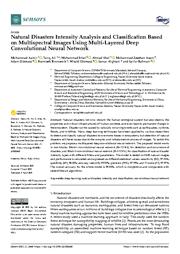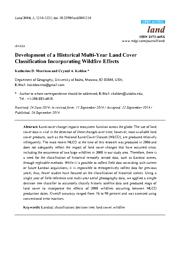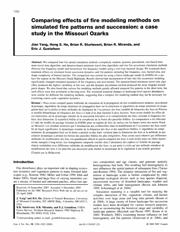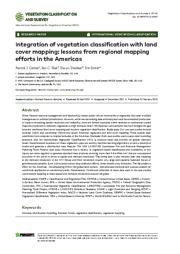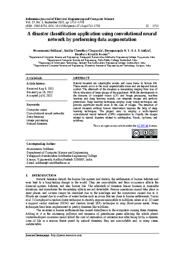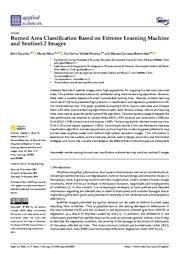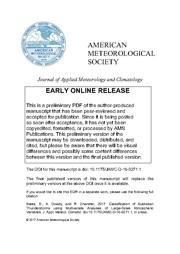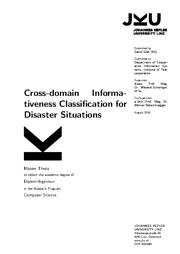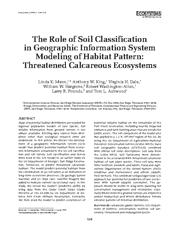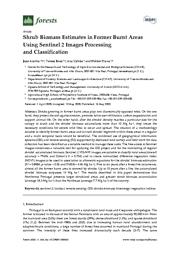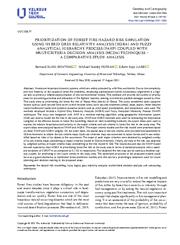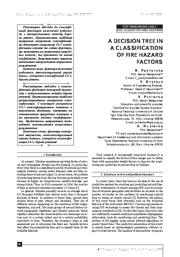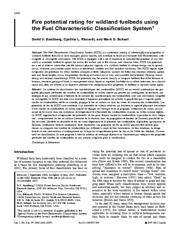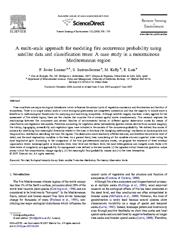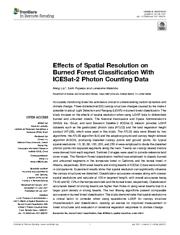A copy of this work was available on the public web and has been preserved in the Wayback Machine. The capture dates from 2021; you can also visit the original URL.
The file type is application/pdf.
Filters
Natural Disasters Intensity Analysis and Classification Based on Multispectral Images Using Multi-Layered Deep Convolutional Neural Network
2021
Sensors
The proposed model works in two blocks: Block-I convolutional neural network (B-I CNN), for detection and occurrence of disasters, and Block-II convolutional neural network (B-II CNN), for classification ...
To tackle this problem, we propose a multilayered deep convolutional neural network. ...
Many machine learning approaches have been used for wildfire predictions since the 1990s. A recent study used a machine learning approach in Italy. ...
doi:10.3390/s21082648
pmid:33918922
pmcid:PMC8069408
fatcat:svfjrho4q5bshm5wisnsf3ti2i
Development of a Historical Multi-Year Land Cover Classification Incorporating Wildfire Effects
2014
Land
The most recent NLCD at the time of this research was produced in 2006 and does not adequately reflect the impact of land cover changes that have occurred since, including the occurrence of two large wildfires ...
Therefore, there is a need for the classification of historical remotely sensed data, such as Landsat scenes, through replicable methods. ...
Our goal, therefore, was to develop a method for classifying a time series of Landsat data using a decision tree classifier developed with a single year of field observations. ...
doi:10.3390/land3041214
fatcat:5ju2lps4bbc4xbmfj4xhvszejq
Comparing effects of fire modeling methods on simulated fire patterns and succession: a case study in the Missouri Ozarks
2008
Canadian Journal of Forest Research
We compared four fire spread simulation methods (completely random, dynamic percolation. size-based minimum travel time algorithm. and duration-based minimum travel time algorithm) and two fire occurrence ...
The comparison was carried out using a forest landscape model (LANDIS) for a surface fire regime in the Missouri Ozark Highlands. ...
Acknowledgements This work was funded by the Northern Research Station of the US Forest Service. We thank the anonymous reviewers and Associate Editor for their helpful comments on this manuscript. ...
doi:10.1139/x07-235
fatcat:bt4xngyxvreonbflmdfm3wlxei
Integration of vegetation classification with land cover mapping: lessons from regional mapping efforts in the Americas
2022
Vegetation Classification and Survey
Georeferenced locations for these vegetation types are used by machine learning algorithms to train a predictive model and generate a distribution map. ...
Methods: Both case studies used a supervised modeling approach with the International Vegetation Classification (IVC) to produce maps that provide for greater thematic detail. ...
Any use of trade, firm, or product names is for descriptive purposes only and does not imply endorsement by the U.S. Government. The LANDFIRE portion was funded by U.S. ...
doi:10.3897/vcs.67537
fatcat:2cx4r3l2ore6dlvzcaiuuhtc34
A disaster classification application using convolutional neural network by performing data augmentation
2022
Indonesian Journal of Electrical Engineering and Computer Science
The project aims to employ a multi-layered convolutional neural network (CNN) organization to classify the images related to natural disasters related to earthquakes, floods, cyclones, and wildfires. ...
These events occur in the most unpredictable times and are beyond human control. ...
Many studies have proposed techniques for natural disaster classification using neural networks and image processing. Deep learning has recently seen remarkable growth in a variety of fields. ...
doi:10.11591/ijeecs.v27.i3.pp1712-1720
fatcat:ionbusig3ngsdpjcfo4fxmrjvi
Burned Area Classification Based on Extreme Learning Machine and Sentinel-2 Images
2021
Applied Sciences
This problem has been extensively addressed using machine-learning algorithms. However, these need a suitable dataset and entail considerable training time. ...
This paper proposes evaluating ELM to map burned areas and compare them with other machine-learning algorithms broadly used. ...
Acknowledgments: The authors of this study offer their special thanks to the FONDECYT Regular Project 2020 No. 1200810 "Very Large Fingerprint Classification based on a Fast and Distributed Extreme Learning ...
doi:10.3390/app12010009
fatcat:r6fqj6aczfajlgxkdmypkpzziu
Classification of Australian Thunderstorms Using Multivariate Analyses of Large-Scale Atmospheric Variables
2017
Journal of Applied Meteorology and Climatology
The results were compared with those obtained by adopting 26 the approach used in an earlier study for the Pacific Northwest, United States. ...
The paper has four objectives with a view to building on previous studies 94 of dry lightning occurrence. ...
Four prediction skill scores were considered, 533 with a focus on dry lightning since it is the primary cause of wildfire ignition. ...
doi:10.1175/jamc-d-16-0271.1
fatcat:qu6iv36o5za37mvrzitsyrqxhi
Cross-domain informativeness classification for disaster situations
2018
Proceedings of the 10th International Conference on Management of Digital EcoSystems - MEDES '18
Comparing the average classification results using 28K tweets for training against using 1K tweets, show a slightly, 1%, higher classification accuracy. ...
Based on training examples or past tweets respectively, the classifier learns a
classification model, which then is used to predict new unseen tweets. ...
doi:10.1145/3281375.3281385
dblp:conf/medes/GrafRSPK18
fatcat:xk2s3pml6zentpefnwzjfmhmam
The Role of Soil Classification in Geographic Information System Modeling of Habitat Pattern: Threatened Calcareous Ecosystems
1999
Ecosystems
Soil classification and survey were used in the GIS model in an earlier study on the US Department of Energy's Oak Ridge Reservation, Tennessee, to predict threatened calcareous habitats. ...
In this article, we discuss the development of a geographic information system (GIS) model that predicts potential habitats from ecosystem information contained in the US soil classification and soil survey ...
Results of this study demonstrate that soil classification can be used to predict TCH/RP at multiple scales. ...
doi:10.1007/s100219900100
fatcat:te5nyajgbfgihmlnufpbrdzvmi
Shrub Biomass Estimates in Former Burnt Areas Using Sentinel 2 Images Processing and Classification
2020
Forests
Five to six years after a forest fire occurrence, almost all the former burnt area is covered by shrubs. Up to 10 years after a fire, the accumulated shrubs' biomass surpasses 14 Mg ha−1. ...
The combined use of geographical information systems (GIS) and remote sensing (RS) supported by dedicated land survey and field work for data collection has been identified as a suitable method to manage ...
It also enables stakeholders to perform dynamic analysis using satellite images in time series processing. ...
doi:10.3390/f11050555
fatcat:gppa3webbbe3zntzwzgm7x2kne
PRIORITIZATION OF FOREST FIRE HAZARD RISK SIMULATION USING HYBRID GREY RELATIVITY ANALYSIS (HGRA) AND FUZZY ANALYTICAL HIERARCHY PROCESS (FAHP) COUPLED WITH MULTICRITERIA DECISION ANALYSIS (MCDA) TECHNIQUES – A COMPARATIVE STUDY ANALYSIS
2021
Geodesy and Cartography
The obtained fire risk map can be used as a decision support system for predicting of the future trends in the study area. ...
The fuzzy sets integrated with AHP in a decision-making algorithm using geographic information system (GIS) was used to model the fire risk in the study area. ...
Acknowledgements The authors would like to appreciate the anonymous reviewers for their helpful comments, time and effort that made this piece of knowledge a better paper. ...
doi:10.3846/gac.2021.13028
fatcat:ljkfihkc2ffgnneknkbpe3eenu
A decision tree in a classification of fire hazard factors
2016
Eastern-European Journal of Enterprise Technologies
The purpose and objectives of the study The purpose of this study is to develop a classification of factors of fire danger with the use of a decision tree. ...
Thus, in 2015 compared to 2014, the number of fires in natural ecosystems increased 2.2 times [1] . ...
doi:10.15587/1729-4061.2016.79868
fatcat:6qgfzcxljje5tc5wq56r52w63y
Fire potential rating for wildland fuelbeds using the Fuel Characteristic Classification SystemThis article is one of a selection of papers published in the Special Forum on the Fuel Characteristic Classification System
2007
Canadian Journal of Forest Research
FCCS fire potentials may be used to classify or compare fuelbeds that differ because of location, structure, passage of time, or management action, based on expected fire behavior or effect outcomes. ...
As a classification tool, they are offered as an objective alternative to categorizing bulk properties of fuelbeds or stylized model inputs. ...
We have not compared these ratings with results from any other crown fire prediction systems. ...
doi:10.1139/x07-093
fatcat:pisfi5m7qvbvxki335pmxhl32i
A multi-scale approach for modeling fire occurrence probability using satellite data and classification trees: A case study in a mountainous Mediterranean region
2008
Remote Sensing of Environment
This research explores the relationships between fire occurrence and several families of environmental factors at different spatial observation scales by means of classification and regression tree models ...
As a general trend, trees considering all the variables showed a spectral index ruling the most explicative split. ...
Finally we wish to thank the Fire Dept. of the Environmental Section, Junta de Castilla y León, for their support to this study by providing digital geographical data. ...
doi:10.1016/j.rse.2007.06.006
fatcat:4jlcca4gqzbdjkayyyeyqomao4
Effects of Spatial Resolution on Burned Forest Classification With ICESat-2 Photon Counting Data
2021
Frontiers in Remote Sensing
This study demonstrates that spatial resolution is a critical factor to consider when using spaceborne LiDAR for canopy structure characterization and classification, opening an avenue for improved measurement ...
Classification accuracies based on strong beams are higher than those of using weak beams due to a larger point density in strong beams. ...
These extreme fire events emphasize the necessity of fire occurrence monitoring and forecasting over space and time (Fusco et al., 2019) . ...
doi:10.3389/frsen.2021.666251
fatcat:d2mwrow7bzbbnkvd5wlsvkdoci
« Previous
Showing results 1 — 15 out of 4,424 results

